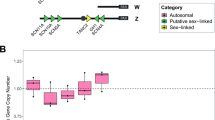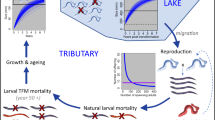Abstract
Bivalve molluscs, the primary vectors of paralytic shellfish poisoning (PSP) in humans, show marked inter-species variation in their capacity to accumulate PSP toxins (PSTs)1 which has a neural basis2,3. PSTs cause human fatalities by blocking sodium conductance in nerve fibres4,5. Here we identify a molecular basis for inter-population variation in PSP resistance within a species, consistent with genetic adaptation to PSTs. Softshell clams (Mya arenaria) from areas exposed to ‘red tides’ are more resistant to PSTs, as demonstrated by whole-nerve assays, and accumulate toxins at greater rates than sensitive clams from unexposed areas. PSTs lead to selective mortality of sensitive clams. Resistance is caused by natural mutation of a single amino acid residue, which causes a 1,000-fold decrease in affinity at the saxitoxin-binding site in the sodium channel pore of resistant, but not sensitive, clams. Thus PSTs might act as potent natural selection agents, leading to greater toxin resistance in clam populations and increased risk of PSP in humans. Furthermore, global expansion of PSP to previously unaffected coastal areas6 might result in long-term changes to communities and ecosystems.
This is a preview of subscription content, access via your institution
Access options
Subscribe to this journal
Receive 51 print issues and online access
$199.00 per year
only $3.90 per issue
Buy this article
- Purchase on Springer Link
- Instant access to full article PDF
Prices may be subject to local taxes which are calculated during checkout




Similar content being viewed by others
References
Bricelj, V. M. & Shumway, S. E. Paralytic shellfish toxins in bivalve mollusks: occurrence, transfer kinetics, and biotransformation. Rev. Fish. Sci. 6, 315–383 (1998)
Twarog, B. M., Hidaka, T. & Yamaguchi, H. Resistance to tetrodotoxin and saxitoxin in nerves of bivalve mollusks. Toxicon 10, 273–278 (1972)
Twarog, B. M. in Proc. 2nd Int. Coral Reef Symp. Vol. 1 (eds Cameron, A. M. et al.) 505–512 (Barrier Reef Committee, Brisbane, 1974)
Narahashi, T. & Moore, J. W. Neuroactive agents and nerve membrane conductances. J. Gen. Physiol. 51, 93–101 (1968)
Hille, B. Pharmacological modifications of the sodium channels of frog nerve. J. Gen. Physiol. 51, 199–219 (1968)
Hallegraeff, G. M. in Manual on Harmful Marine Microalgae (eds Hallegraeff, G. M., Anderson, D. M. & Cembella, A. D.) 25–49 (UNESCO, Paris, 2003)
Fozzard, H. A. & Hanck, D. Structure and function of voltage-dependent sodium channels: comparison of brain II and cardiac isoforms. Physiol. Rev. 76, 887–926 (1996)
Catterall, W. A. From ionic currents to molecular mechanisms: the structure and function of voltage-gated sodium channels. Neuron 26, 13–25 (2000)
Martin, J. L. & Richard, D. in Harmful and Toxic Algal Blooms (eds Yasumoto, T., Oshima, Y. & Fukuyo, Y.) 3–6 (International Oceanographic Commission of UNESCO, Paris, 1996)
Bricelj, V. M., Cembella, A. D., Laby, D., Shumway, S. E. & Cucci, T. L. in Harmful and Toxic Algal Blooms (eds Yasumoto, T., Oshima, Y. & Fukuyo, Y.) 405–408 (International Oceanographic Commission of UNESCO, Paris, 1996)
MacQuarrie, S. P. Inter- and Intra-population Variability in Behavioral and Physiological Responses of the Softshell Clam, Mya arenaria, to the PSP Toxin-producing Dinoflagellate, Alexandrium tamarense. Thesis, Dalhousie Univ. (2002)
Terlau, S. H. et al. Mapping the site of block by tetrodotoxin and saxitoxin of sodium channel II. FEBS Lett. 293, 93–96 (1991)
Satin, J. et al. A mutant of TTX-resistant cardiac sodium channels with TTX-sensitive properties. Science 256, 1202–1205 (1992)
Sivilotti, L., Okuse, K., Akopian, A. N., Moss, S. & Wood, J. N. A single serine residue confers tetrodotoxin insensitivity on the rat sensory-neuron-specific sodium channel SNS. FEBS Lett. 409, 49–52 (1997)
Jaenisch, R. & Bird, A. Epigenetic regulation of gene expression: how the genome integrates intrinsic and environmental signals. Nature Genet. 33 (Suppl.), 245–254 (2003)
Auld, V. J. et al. A neutral amino acid change in segment IIS4 dramatically alters the gating properties of the voltage-dependent sodium channel. Proc. Natl Acad. Sci. USA 87, 323–327 (1990)
Lipkind, G. & Fozzard, H. A. A structural model of the tetrodotoxin and saxitoxin binding site of the Na+ channel. Biophys. J. 66, 1–13 (1994)
Kontis, K. J. & Goldin, A. L. Site-directed mutagenesis of the putative pore region of the rat IIA sodium channel. Mol. Pharmacol. 43, 635–644 (1993)
Kvitek, R. G. & Beitler, M. K. Relative insensitivity of butter clam neurons to saxitoxin: a pre-adaptation for sequestering paralytic shellfish poisoning toxins as a chemical defense. Mar. Ecol. Prog. Ser. 69, 47–54 (1991)
Liu, M.-Y., Bull, D. L. & Plapp, F. W. Jr Effects of exposure to cypermethrin on saxitoxin binding in susceptible and pyrethroid-resistant houseflies. Arch. Insect Biochem. Physiol. 37, 73–79 (1998)
He, H. et al. Identification of a point mutation in the para-type sodium channel gene from a pyrethroid-resistant cattle tick. Biochem. Biophys. Res. Commun. 261, 558–561 (1999)
Yamashita, M.-Y. et al. Binding properties of 3H-PbTx-3 and 3H-saxitoxin to brain membranes and to skeletal muscle membranes of puffer fish Fugu pardalis and the primary structure of a voltage-gated Na+ channel α-subunit (fMNa1) from skeletal muscle of F. pardalis. Biochem. Biophys. Res. Commun. 267, 403–412 (2000)
Geffeney, S., Brodie, E. D. Jr, Ruben, P. C. & Brodie, E. D. III Mechanisms of adaptation in a predator-prey arms race: TTX-resistant sodium channels. Science 297, 1336–1339 (2002)
Bricelj, V. M., Lee, J. H. & Cembella, A. D. Influence of dinoflagellate cell toxicity on uptake and loss of paralytic shellfish toxins in the northern quahog, Mercenaria mercenaria (L.). Mar. Ecol. Prog. Ser. 74, 33–46 (1991)
Oshima, Y. in Manual on Harmful Marine Microalgae (eds Hallegraeff, G. M., Anderson, D. M. & Cembella, A. D.) 81–94 (International Oceanographic Commission Manuals and Guides 33, UNESCO, Paris, 1995)
Storici, L., Lewis, K. & Resnick, M. A. In-vivo site-directed mutagenesis using oligonucleotides. Nature Biotechnol. 19, 773–776 (2001)
Linford, N. J., Cantrell, A. R., Qu, Y., Scheuer, T. & Catterall, W. A. Interaction of batrachotoxin with the local anesthetic receptor site in transmembrane segment IVS6 of the voltage-gated sodium channel. Proc. Natl Acad. Sci. USA 95, 13947–13952 (1998)
Acknowledgements
We thank B. M. Twarog, whose seminal work in the 1970s inspired this study, for conducting the initial nerve tests; P. Chang for participating in the burrowing experiment; M. Quilliam and the IMB analytical toxins group for providing STX for nerve tests; and E. M. Sharp and M. Iszard for technical assistance. This work was supported by a US NOAA-ECOHAB grant to V.L.T. and V.M.B., a NOAA-ECOHAB grant to L.C., V.L.T. and V.M.B., and an NIH research grant to W.A.C.
Author information
Authors and Affiliations
Corresponding author
Ethics declarations
Competing interests
The authors declare that they have no competing financial interests.
Supplementary information
Supplementary Figure S1
Illustrates voltage-dependent electrophysiological properties (activation and inactivation of the Na+ current) of transfected wild-type and mutant Na+ channels. (DOC 567 kb)
Supplementary Discussion
Includes a discussion of differences in the sensitivity to toxins between Mya arenaria nerves and transfected Na+ channels, and references cited therein. (DOC 27 kb)
Supplementary Methods
Describes the methods of clam nucleic acid extraction, production of cDNA, isolation of Na+ channel specific fragments, determination of the Na+ channel sequence from individual clams, and the construction of Na+ channel mutations, including cited references. (DOC 40 kb)
Rights and permissions
About this article
Cite this article
Bricelj, V., Connell, L., Konoki, K. et al. Sodium channel mutation leading to saxitoxin resistance in clams increases risk of PSP. Nature 434, 763–767 (2005). https://doi.org/10.1038/nature03415
Received:
Accepted:
Issue Date:
DOI: https://doi.org/10.1038/nature03415
This article is cited by
-
A Transcriptome Analysis of Neural Tissue of Litopenaeus vannamei After Acute Exposure to Alexandrium pacificum
Journal of Ocean University of China (2024)
-
The molecular basis and evolution of toxin resistance in poison frogs
Evolutionary Ecology (2023)
-
The physiological function of different voltage-gated sodium channels in pain
Nature Reviews Neuroscience (2021)
-
Harmful algal blooms and shellfish in the marine environment: an overview of the main molluscan responses, toxin dynamics, and risks for human health
Environmental Science and Pollution Research (2021)
-
Experimental exposure of the mussel Mytilus platensis (d’Orbigny, 1842) to the dinoflagellate Alexandrium catenella from Argentine Patagonia
Ecotoxicology (2020)
Comments
By submitting a comment you agree to abide by our Terms and Community Guidelines. If you find something abusive or that does not comply with our terms or guidelines please flag it as inappropriate.



